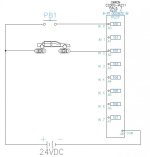kannan_kathiresan
Member
OP
Yes, that relay should be fine.
A voltage regulator should work, but will produce a LOT of heat. I'm not discounting the idea, I just want you to be aware.
If you're going to purchase a 24VDC Power Supply, maybe take a look for a +/-12VDC supply large enough to give 12 Volts for the motor (I think that would be the nominal voltage of your motor, and would only be a minor change in speed) and 24 Volts for your inputs. Perhaps a reasonable price can be found, and keep your component count low.
I was going to post this earlier, but have been in meetings all afternoon, but EZAutomation has 12mm inductive proximity switches for $9.99US. Unfortunately, If VAT bumps your cost up to $80.00US, then it may not be an option for you.
We can use a heat sink for that right ? does my heat sink and voltage regulator go along together ?
I have a SMPS which can supply 24VDC. However, I have a power supply module which can supply 15V. Should i directly power up my motor from that via a relay ? If I do that, how would my PLC know that a motor is on ?
btw thank you so much for that inductive proximity switch! I found this in a Malaysian website. So, I can order it without VAT
the voltage specs :
Switching Voltage 200 VDC/AC Max
Will i be able to supply 24VDC and turn it on ?





